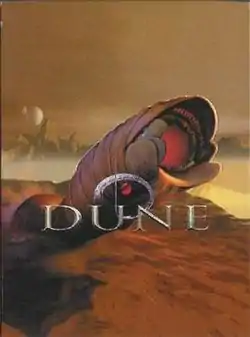Dune (card game)
Dune is an out-of-print collectible card game produced by Last Unicorn Games and Five Rings Publishing Group, and later Wizards of the Coast. Set in the Dune universe based on the books written by Frank Herbert,[1] the game pits two or more players against each other, each in control of a minor house vying for entry in the Landsraad.[2]
 Cover image | |
| Designer(s) | Owen Seyler and Matthew Colville |
|---|---|
| Publisher(s) | Five Rings Publishing Group Wizards of the Coast |
| Players | 2–8 |
| Playing time | ~ 1 hour |
| Random chance | Some |
| Skill(s) required | Card playing Arithmetic Basic reading ability |
Publishing history
Originally released in 1997 as Dune: Eye of the Storm by a partnership of Five Rings Publishing Group and Last Unicorn Games, negotiated the license with the Herbert Estate and oversaw the design and art direction of the game. The set included 301 cards available in both starter boxes and booster packs. Although Ally and Homeworld cards were only available in starter boxes, not all Ally cards were included in a given starter (e.g. Piter de Vries, Liscia Theirese), giving rise to the collectable/tradable game element. A small number of Promotional cards were also released to people requesting additional information about the game prior to Eye of the Storm's initial release. All of these cards have "Preview" on the left-hand side of the card face.
When Wizards of the Coast purchased Five Rings later that year, Dune: Eye of the Storm underwent a major shift.[3] In a program called Rolling Thunder, small expansions, called "Chapters", of the game were released every two months. While meant to keep the pace of collecting exciting, it resulted in high duplicate rates in booster packs and a competitive landscape constantly in flux.
In 1998, Wizards of the Coast released two more complete sets,[4] Dune: Judge of the Change (183 cards, covering the arrival of House Atreides on Arrakis)[5] and Dune: Thunder at Twilight (178 cards, covering the reclaiming of Arrakis by House Harkonnen), but the challenging gameplay proved too difficult for younger players. This ultimately led to the collapse of the Dune CCG.
Two more expansions, Dune: Second Moon Rising (the rise of Paul Atreides) and Dune: Fall of the Padishah (the defeat of Padishah Emperor Shaddam IV), were planned for release in 1998. However, the game was canceled before they were printed.[6]
Gameplay
Players take the role of minor houses vying for entry into the Landsraad. They are sponsored in this effort by one of six Great Houses/Factions (House Atreides, Bene Gesserit Sisterhood, House Corrino, the Fremen, House Harkonnen, and the Spacing Guild), and must choose one Homeworld, as well as a number of unique Allies and Holdings to make up their Imperial Deck. Players also have a House Deck containing non-unique cards that represent their Aides, Personnel, Equipment, Plans and Tactics (random Event cards may also be included in the House Deck).[7]
The Judge of the Change expansion introduced three new Factions (the Spice Miner's Guild, the Water Seller's Union, and the Dune Smugglers), and the Thunder at Twilight expansion contained modified House Atreides, House Corrino and House Harkonnen starter sets (reflecting the period in the Dune novel when House Atreides took possession of Arrakis from the Harkonnen).
Each player begins the game with a homeworld and small amount of solaris.[8] Players compete over Imperial Deck Allies and Holdings through an auction-style mechanic, while House Deck resources are paid for and deployed from a player's hand.
Players attack one another through Intrigue, Battle, Arbitration, and Dueling Rites to gain political standing and wealth. Allies and Aides can only participate in a particular Rite if they have the Talent for it (displayed on their card). When a player uses a deployed Ally or Aide to attack or defend, they must Tap that card and it cannot be used again until the next turn. This may leave the player open to an attack from another player, so it becomes important to have multiple elements of attack and defense deployed at all times. Also, Tactic cards make it possible for one player to interfere with an attack occurring between two other players and influence the outcome without using any of the interfering player's Allies or Aides. Allies and Aides that are defeated in an attack are usually not removed from play but are turned face down, and may be resurrected after a few turns.
The mystical elements of Prophecy and Bene Gesserit Weirding ways can also be utilized to significantly further one's agenda. Victory can be gained once a player's House accumulates 10 or more spice units and 10 or more Favor points.
References
- Varney, Allen (December 1997), "Inside the Industry", The Duelist (#20), p. 90
- Miller, John Jackson (2003). Scrye Collectible Card Game Checklist & Price Guide (2nd ed.). pp. 168–172.
- "Wizards of the Coast News", The Duelist (#19), p. 17, October 1997
- "Dune Classic CCG by Steven Baumrucker MD". 3 May 2004. Archived from the original on 3 May 2004.
- "Game News & Updates", The Duelist (#21), p. 86, January 1998
- "CCG - Collectors of Dune".
- Dancey, Ryan S. (December 1997), "Dune: The Sleeper Awakes", The Duelist (#20), pp. 108, 110
- Seyler, Owen (March 1998), "Dune: The Taming of Arrakis", The Duelist (#23), pp. 80–81
External links
- Baumrucker, MD, Steven (May 2003). "Dune: Classic CCG". Scrye. Internet Archive. Archived from the original on May 3, 2004. Retrieved May 3, 2004.
- Dune Collectible Card Game at BoardGameGeek
- Dune (card game) on Dunepedia the Dune Encyclopedia
- Good Dune CCG overview on BoardGameGeek